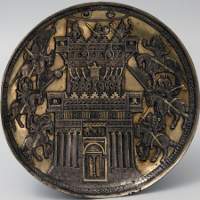|
|
Post by Druzhina on Feb 3, 2017 7:42:02 GMT 3
I have found a good image of armoured cavalrymen attacking a fortress, from Semireçye in Central Asia, 9th-10th century, State Hermitage Museum, St. Petersburg, S-46 It is probably the siege of Jericho even though the man holding an ark and the seven trumpeters are on the lower level of the fortification. There are three standards shown, various maces, one perhaps an animals head, the bowcases are for unstrung bows, the quivers for arrows point upwards. The helmets have knobs or points on top and a hint of a nasal similar to illustrations of helmets from the Tarim basin. Mirror site: armoured cavalrymen attacking a fortress, from Semireçye in Central Asia, 9th-10th century, State Hermitage Museum, St. Petersburg, S-46Druzhina Plates with figures from Persia and Central Asia |
|
|
|
Post by H. İhsan Erkoç on Feb 3, 2017 11:58:23 GMT 3
Very nice piece, I remember seeing it in Nicolle's book from the Osprey series.
I wonder which tribe/people this plate is depicting (it depicts the siege of Jericho, but I mean from whom the models are based on). 9th-10th centuries corresponds to the period of Qarluq domination in the Semirechye (Jetysu/Yedisu) region.
|
|
|
|
Post by Temüjin on Feb 3, 2017 15:03:41 GMT 3
yeah must be Qarluqs i guess.
|
|
|
|
Post by H. İhsan Erkoç on Feb 3, 2017 21:53:21 GMT 3
Yes, most probably they are Qarluqs.
|
|
|
|
Post by Druzhina on Feb 6, 2017 6:55:53 GMT 3
What might be the reason that it is thought to be made in Semirechye (Seven Rivers) (?). The question mark is the Hermitage's. Michael Gorelik, in: Islamic Arms and Armour, wrote that it was a Soghdian silver plate from the eighth to ninth centuries. David Nicolle in his PhD disitation wrote it was a Silver dish, 9th-10th centuries AD, Transoxanian or Khurāsānī, but, in Armies of the Caliphates 862-1098 wrote that it was made near the islamic frontier at Semireçye in Central Asia. Druzhina Illustrations of Costume & Soldiers |
|
|
|
Post by H. İhsan Erkoç on Feb 6, 2017 11:05:58 GMT 3
Interesting. The style of the dish looks Sassanid indeed.
|
|
|
|
Post by Temüjin on Feb 6, 2017 15:10:13 GMT 3
the first question to me is, what's the provenance of this plate? i mean where did they found this plate?
scond question is, if this is indeed supposed to be the siege of Jericho, which religions really care about this siege? i assume it's most important to Jews, so that points to Khazars? if you lok at the merlons, they look clearly mideastern, so it's not from the eastern steppe. so the Zhetysu region seems to be about the eastern limit of possible provenance.
|
|
|
|
Post by Druzhina on Feb 7, 2017 8:04:53 GMT 3
|
|